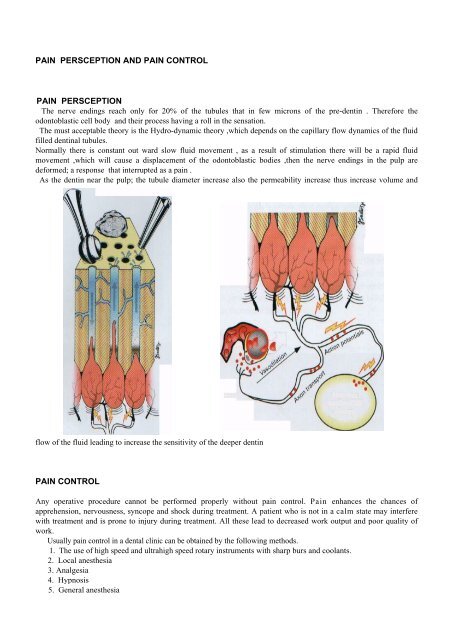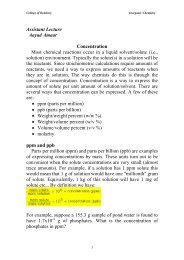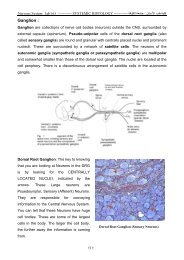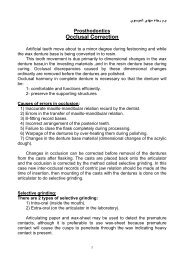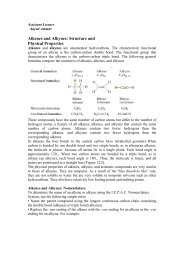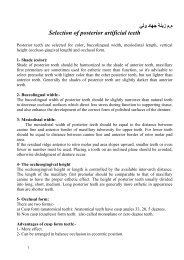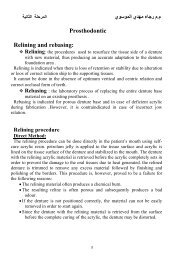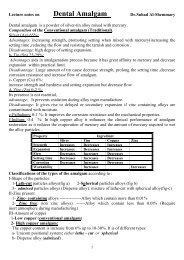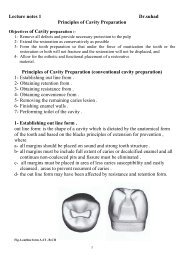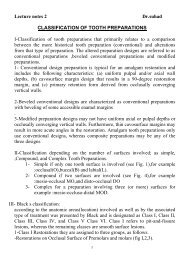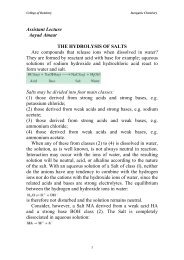pain persception and pain control pain persception pain control
pain persception and pain control pain persception pain control
pain persception and pain control pain persception pain control
Create successful ePaper yourself
Turn your PDF publications into a flip-book with our unique Google optimized e-Paper software.
PAIN PERSCEPTION AND PAIN CONTROL<br />
PAIN PERSCEPTION<br />
The nerve endings reach only for 20% of the tubules that in few microns of the pre-dentin . Therefore the<br />
odontoblastic cell body <strong>and</strong> their process having a roll in the sensation.<br />
The must acceptable theory is the Hydro-dynamic theory ,which depends on the capillary flow dynamics of the fluid<br />
filled dentinal tubules.<br />
Normally there is constant out ward slow fluid movement , as a result of stimulation there will be a rapid fluid<br />
movement ,which will cause a displacement of the odontoblastic bodies ,then the nerve endings in the pulp are<br />
deformed; a response that interrupted as a <strong>pain</strong> .<br />
As the dentin near the pulp; the tubule diameter increase also the permeability increase thus increase volume <strong>and</strong><br />
flow of the fluid leading to increase the sensitivity of the deeper dentin<br />
PAIN CONTROL<br />
Any operative procedure cannot be performed properly without <strong>pain</strong> <strong>control</strong>. Pain enhances the chances of<br />
apprehension, nervousness, syncope <strong>and</strong> shock during treatment. A patient who is not in a calm state may interfere<br />
with treatment <strong>and</strong> is prone to injury during treatment. All these lead to decreased work output <strong>and</strong> poor quality of<br />
work.<br />
Usually <strong>pain</strong> <strong>control</strong> in a dental clinic can be obtained by the following methods.<br />
1. The use of high speed <strong>and</strong> ultrahigh speed rotary instruments with sharp burs <strong>and</strong> coolants.<br />
2. Local anesthesia<br />
3. Analgesia<br />
4. Hypnosis<br />
5. General anesthesia
THE USE OF HIGH SPEED AND ULTRAHIGH SPEED ROTARY INSTRUMENTS WITH<br />
SHARP BURS AND COOLANTS<br />
When new <strong>and</strong> sharp burs of appropriate sizes are used with high speed <strong>and</strong> ultrahigh speed with coolants the <strong>pain</strong> is<br />
almost eliminated during all operative procedures. Even lengthy <strong>and</strong> complicated procedures are performed very<br />
quickly without any discomfort to the patient.<br />
LOCAL ANESTHESIA<br />
Commonly local anesthesia is given parenterally. A very small amount is adequate for the various operative<br />
procedures. Before injection topical anesthetic solution is applied on the site where the injection is to be given to<br />
eliminate <strong>pain</strong> of injection. The solution should be at body temperature <strong>and</strong> sensitivity test must be done before<br />
injecting the required dose.<br />
ANALGESIA<br />
Inhalation sedation may be used for the patient who has a low threshold of <strong>pain</strong> <strong>and</strong> are very apprehensive. In these<br />
patients, nitrous oxide <strong>and</strong> oxygen increase threshold of <strong>pain</strong>. Inhalation sedation does not mean general anesthesia<br />
rather it is sometimes given along with local anesthetic injections to elevate threshold of <strong>pain</strong>. With this patient is<br />
conscious of surrounding activities.<br />
HYPNOSIS<br />
Hypnosis is also used to reduce or alleviate apprehension <strong>and</strong> <strong>pain</strong>. It is done through suggestion of relaxation. Dental<br />
surgeon should have knowledge about the patient having conditions associated with psychological, emotional<br />
<strong>and</strong> mental factors. Patient undergoing hypnosis feels relaxed <strong>and</strong> less fatigued at the end of dental treatment.<br />
During treatment, dental surgeon <strong>and</strong> patient remain in & more relaxed environment.<br />
Cardiovascular System<br />
Patient's heart rate, blood pressure (BP). <strong>and</strong> pulse rate should be evaluated. A patient having heart disease like<br />
valvular defect should be operated under antibiotic coverage.(in conservative dentistry, endodontology or sub gingival<br />
caries<br />
Large amount of anesthetic drugs may cause decreased blood pressure which leads to unconsciousness<br />
due to reduced oxygen supply to the brain. Generally. local anesthetic preparations contain 1:80.000 to<br />
200.000 concentration of adrenaline <strong>and</strong> 2 percent local anesthetic salt, which have good safety margin. The<br />
increased concentration of adrenaline may cause increase in blood pressure, rise in heart rate <strong>and</strong> arrhythmia also. In<br />
cardiac patients local anesthetic solution without adrenaline should be used.<br />
CENTRAL NERVOUS SYSTEM<br />
Side effects of the local anesthesia are more common in central nervous system. Therapeutic dose generally may<br />
cause depression. Very high dose may cause tonic-clonic seizure, decreased blood pressure <strong>and</strong> respiratory arrest<br />
leading to death.<br />
Allergy Most dangerous complication is allergy, because it is life-threatening in most of the cases. Hence,<br />
proper history about allergy is m<strong>and</strong>atory before administering local anesthesia.<br />
Pregnancy: It is better to use minimum amount of local anesthetic drug specially during pregnancy,<br />
Hepatic dysfunction: In hepatic dysfunction, the biotransformation cannot take place properly. It causes<br />
high level of local anesthetic in the blood. Therefore, low doses of local anesthetic should be administered, or using<br />
material that not biotransformation in the lever.<br />
Renal dysfunction: In patients with kidney diseases, local anesthetics do not cause any extra problem to the<br />
patient.<br />
Thyroid diseases: Careful finding for un<strong>control</strong>led hyperthyroidism is required because such patients<br />
exhibit increased response to the vasoconstrictor (adrenaline) present with local anesthetics. Therefore
solutions without adrenaline should be used.<br />
Age: In very young <strong>and</strong> extremely old persons, less than the normal therapeutic dose should be given.<br />
Advantages of Local Anesthesia<br />
Following are the main advantages of local anesthesia during dental procedure.<br />
1. Better patient co-operation: If the region or tooth is fully anesthetized patient does not feel <strong>pain</strong>. It removes fear<br />
<strong>and</strong> apprehension. Patient appears relaxed <strong>and</strong> gives better cooperation <strong>and</strong> dental procedure can be done in a<br />
calm environment<br />
2. Control of saliva: Increased flow of saliva during dental procedure is the consequence of "touch" sensation to<br />
various parts of the oral cavity during treatment.Under local anesthesia, there is reduction of sensation<br />
which results in decreased salivary flow.<br />
3. Control of bleeding: In the local anesthesia, a vasoconstrictor, usually epinephrine or adrenaline is added<br />
mainly for increasing the period of anesthesia by decreasing flow of blood at the site of injection. This<br />
temporary reduction in blood flow helps in <strong>control</strong>ling bleeding during any dental procedure.<br />
4. Operative efficiency: By the use of local anesthesia, <strong>pain</strong> disappears, which is associated with reduced<br />
blood flow <strong>and</strong> apprehension. Under local anesthesia, the patient is most cooperative. Therefore, the<br />
confidence <strong>and</strong> work efficiency is increased.<br />
Steps in Administration of Local Anesthesia<br />
1. Patient should be in supine position. This is preferred because it favors good blood supply <strong>and</strong> pressure to<br />
brain.<br />
2. Syringe aspiration: Before injecting the solution into the body, first a little aspiration in the syringe is done to<br />
avoid chances of injecting solution in the blood vessels <strong>and</strong> consequently preventing toxic effect of local<br />
anesthesia.<br />
3. The local anesthetic solution should not be injected into the inflamed <strong>and</strong> infected tissues to prevent<br />
possible spread of infection. In inflamed areas, the local anesthetic solution does not work properly due to<br />
acidic medium of inflamed tissues.<br />
4. In every patient, disposable needle <strong>and</strong> syringe should be used. The needle should be of proper gauge <strong>and</strong><br />
length. Needle should remain covered with cap till its use.<br />
5. Before loading syringe the temperature of the solution should be brought to body temperature to make<br />
injecting a <strong>pain</strong>less procedure.<br />
6. Before loading the solution in the syringe, it should be confirmed that anesthetic solution is fresh <strong>and</strong> not<br />
expired.<br />
7. Before injecting the local anesthesia, the site of injection should be cleaned free of debris <strong>and</strong> saliva by a<br />
sterile cotton pellet.<br />
8. Topical surface anesthetic solution or jelly may be applied before injecting the needle for <strong>pain</strong>less<br />
penetration of needle.<br />
9. Needle should be inserted at the junction of alveolar mucosa <strong>and</strong> vestibular mucosa <strong>and</strong> the angle of needle<br />
should not be parallel to the long axis of the tooth . Injection parallel to long axis causes more <strong>pain</strong> (Fig. 15.1).<br />
10. Anesthetic solution is injected slowly not more than 1 ml per minute <strong>and</strong> in small increments to provide enough<br />
time for tissue diffusion of the solution. Needle should be continuously inserted inside till the periosteum or<br />
bone is felt by way<br />
of slight increase in resistance of the needle movement The needle is slightly withdrawn <strong>and</strong> here the remaining<br />
solution is injected. 11: Two minutes after injection the effect of anesthesia is checked before starting operative<br />
procedure.<br />
12. Patient should be carefully watched during <strong>and</strong> after local anesthesia for about half an hour for delayed<br />
reactions<br />
13. After use. the needle <strong>and</strong> syringe should be discarded in a container. The container should be leak-proof <strong>and</strong><br />
hard-walled.<br />
Therefore for the <strong>control</strong> of discomfort <strong>and</strong> <strong>pain</strong> the use of sharp burs, coolants, hypnosis, analgesia <strong>and</strong> local<br />
anesthesia must be used to make operative procedures pleasant <strong>and</strong> acceptable to the patient<br />
Genera! anesthesia: It is only required when all the above methods fail or the mouth opening is poor
Incorrect entry point (junction of loose <strong>and</strong> fixed mucosa)<br />
Correct lip<br />
position<br />
_ Correct 1 ar| 9 |e<br />
Correct enlry point<br />
Incorrecl lip<br />
position<br />
Incorrect angle<br />
anesthesia on the buccal side of upper premolar<br />
Fig. 15.1: Correct angle of needle for injecting local
This document was created with Win2PDF available at http://www.win2pdf.com.<br />
The unregistered version of Win2PDF is for evaluation or non-commercial use only.<br />
This page will not be added after purchasing Win2PDF.


